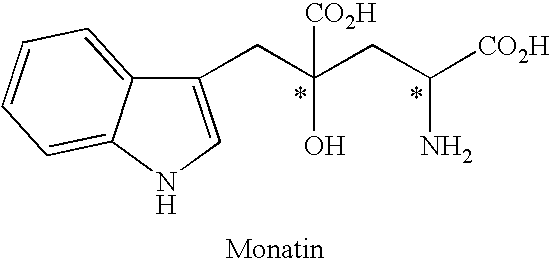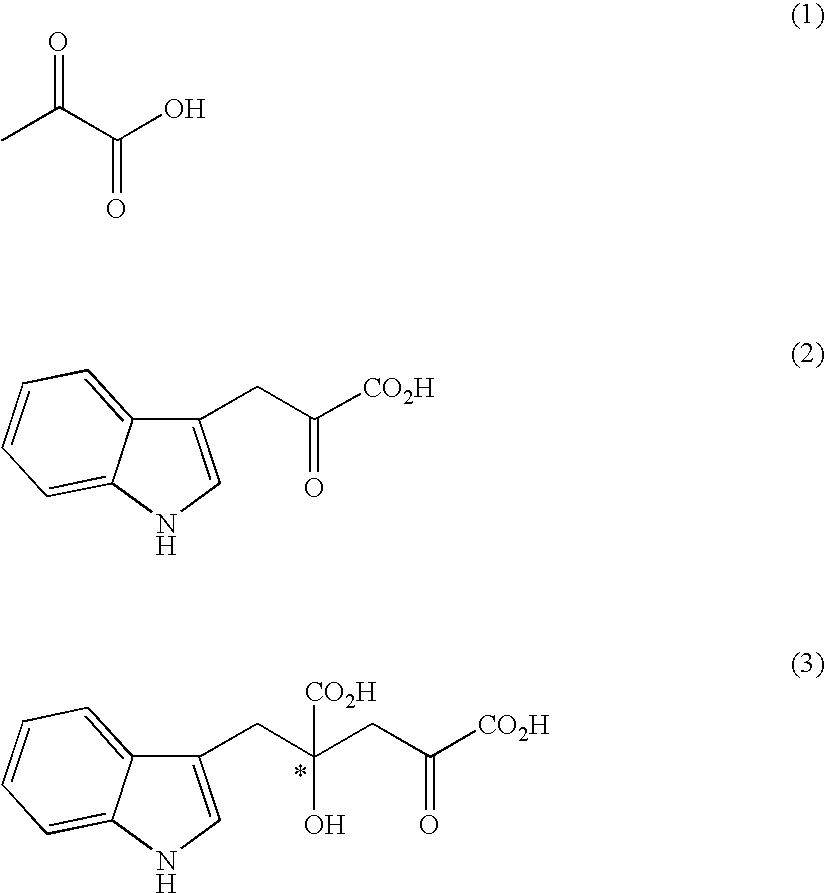Process for producing an optically active compound
a technology of optical active compound and compound, applied in the field of optical active compound production, can solve the problems of pyruvic acid, and inability to apply to the production of monatin using pyruvic acid
- Summary
- Abstract
- Description
- Claims
- Application Information
AI Technical Summary
Benefits of technology
Problems solved by technology
Method used
Image
Examples
example 1
Asymmetric Cross Aldol Reaction
[0099]Under an argon atmosphere, 0.21 g of indole-3-pyruvic acid was suspended in 5.0 ml of water, which was dissolved by addition of 2N sodium hydroxide aqueous solution and adjusted to pH 12. Then, the solution was adjusted to pH 7 to 10 by addition of 1N hydrochloric acid, and then sodium pyruvate (0.34 g) and the solution (1.0 ml) prepared in Preparation 1 were added. At this stage, the pH of the solution was confirmed with a pH meter, and if necessary the solution was adjusted to the prescribed pH with 2N sodium hydroxide aqueous solution or 1N hydrochloric acid. The mixture was stirred at room temperature for 5 hours, and the yield and enantiomeric excess of 4-hydroxy-4-(3-indolylmethyl)-2-hydroxyiminoglutaric acid in the reaction mixture were determined.
example 13
Solvent Effect
[0102]In place of water as solvent, 5 ml of methanol was used, but otherwise the experiment was carried out in the same manner as in Example 2. Analysis of the reaction mixture indicated that 4-hydroxy-4-(3-indolylmethyl)-2-hydroxyiminoglutaric acid was formed in 19% (enantiomeric excess 19%; selectivity for the 4-R isomer). From this result, it was found that water is better than methanol in yield and enantiomeric excess (Examples 2 and 13).
example 14
Effect of Bases
[0103]Under an argon atmosphere, 1.00 g of indole-3-pyruvic acid was suspended in 15.0 ml of water, which was then added with 1.72 ml of morpholine (4 fold molar excess to indole-3-pyruvic acid) and the complex solution (6.0 ml) prepared in Preparation 1 (Table 1). At this stage, the pH of the reaction mixture was 7.1. After stirring at room temperature for 5 hours, the yield and enantiomeric excess of 4-hydroxy-4-(3-indolylmethyl)-2-hydroxyiminoglutaric acid in the reaction mixture were determined.
PUM
| Property | Measurement | Unit |
|---|---|---|
| pH | aaaaa | aaaaa |
| molar ratio | aaaaa | aaaaa |
| molar ratio | aaaaa | aaaaa |
Abstract
Description
Claims
Application Information
 Login to View More
Login to View More - R&D
- Intellectual Property
- Life Sciences
- Materials
- Tech Scout
- Unparalleled Data Quality
- Higher Quality Content
- 60% Fewer Hallucinations
Browse by: Latest US Patents, China's latest patents, Technical Efficacy Thesaurus, Application Domain, Technology Topic, Popular Technical Reports.
© 2025 PatSnap. All rights reserved.Legal|Privacy policy|Modern Slavery Act Transparency Statement|Sitemap|About US| Contact US: help@patsnap.com



